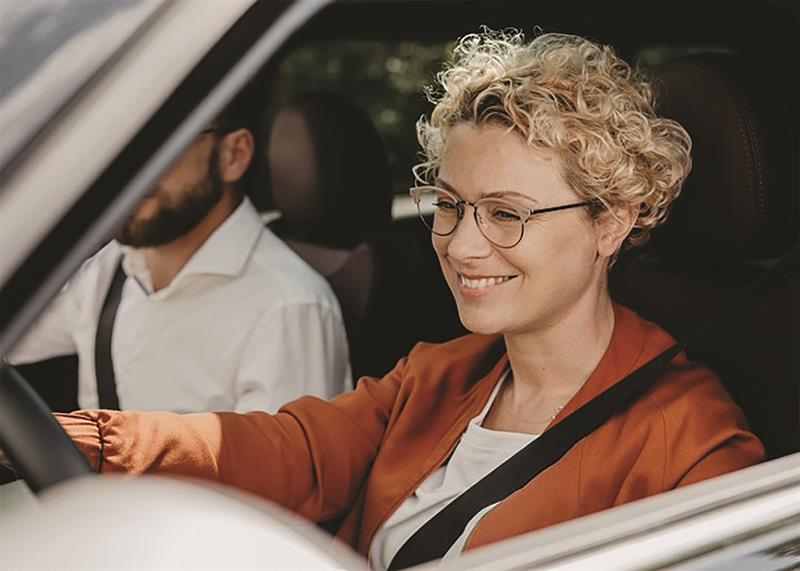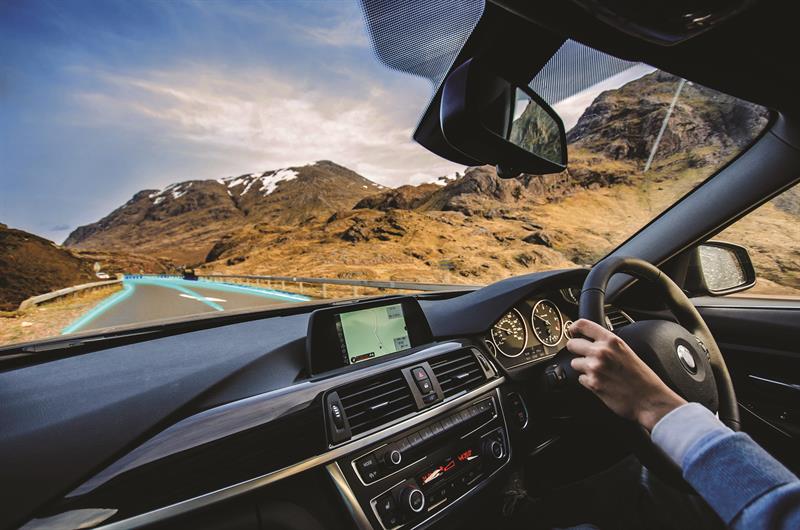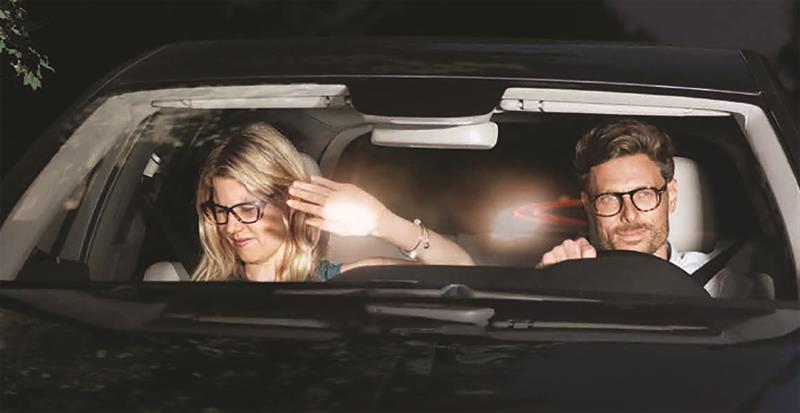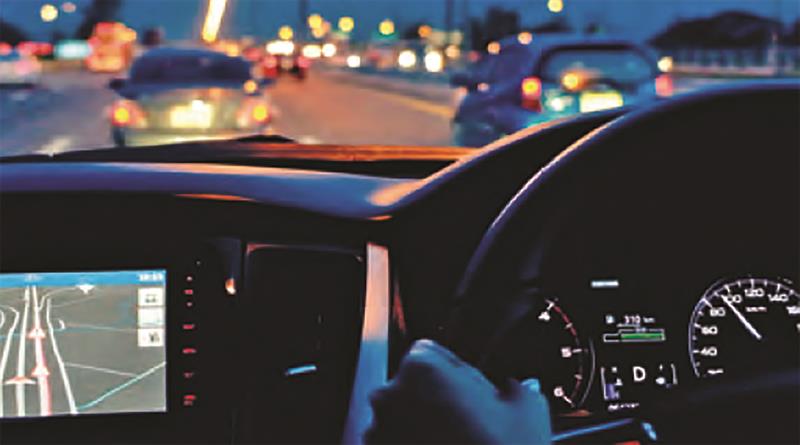
Essilor: Crizal Drive
Originally only available as a coating for Essilor RoadPilot driving lenses, the Crizal Drive lens range has recently been expanded to include varifocal lenses Varilux X and E series, Varilux Physio 3.0 and single vision lenses.
Essilor’s Road Pilot lens features the compnay’s Wavefront management system for optical maximisation across the whole lens, while the Varilux versions include wide distance and intermediate vision zones.
A survey conducted by the EyeCare Trust showed that 31% of people avoided night-time driving because of safety concerns, prompting Essilor to develop a coating that it said reduces reflections by up to 90% when driving at night.
Crizal Drive minimises reflection at the exact point where the eye is most sensitive to light at night and eliminates back surface reflections.
The coating comes with a two-year scratch-free guarantee and features scratch and smudge resistance alongside hydrophobic qualities.
Rodenstock: Rodenstock Road
Rodenstock’s driving spectacles have been developed to address changing lighting conditions, headlight dazzle, reflecting lanes and other challenges drivers’ eyes face when travelling.
The Rodenstock Road lenses are suitable for non-driving situations too, ensuring that wearers do not have to change their spectacles when entering and exiting a vehicle. Fatigue-free and optimised spatial vision in changing lighting conditions are capabilities the lenses provide both for driving and standard wear.
Solitaire Protect Road 2 coating is used on the driving lenses and reduces dazzling effects from modern xenon or LED headlights. Agitating reflections, such as those from wet road, are reduced significantly with enhanced contrast during the day also a benefit for driving.
Rodenstock’s driving lenses have been rated as ‘very good’ by the Technical Inspection Association in Rheinland, Germany.

Hoya: EnRoute
Available in both single vision and progressive variants, Hoya’s EnRoute driving lenses are designed to maximise efficiency in looking quickly between mirrors, the road, navigation devices and the dashboard while driving.
Hoya explained that 90% of a driver’s reaction time depends on vision, creating the need for clear vision in situations where glare and dazzle are common. The EnRoute driving lens filters out blue light, which contributes to glare, and has been designed to provide the maximal clear field of vision.
Hoya also produces a Pro version of the EnRoute lens in single vision and multifocal that includes improved colour contrast. The Pro variation of the lens is recommended for anyone who drives professionally, including delivery and taxi drivers.
Zeiss: DriveSafe
DriveSafe lenses from Zeiss have been optimised for driving with Luminance Design Technology and DuraVision DriveSafe coating. These features provide better vision in low light conditions, reduced glare and clear visibility.
Luminance Design Technology takes different pupil sizes in differing light conditions into account, accounting for driving in mesopic conditions and making space perception and distance assessment more comfortable for drivers.
Zeiss’ DuraVision coating reduces perceived glare by up to 64% according to the company, reflecting the wavelengths of light that cause perceived glare.
Optimised distance and intermediate viewing zones reduce the need for horizontal head movement with the lens design calibrated for the percentage of time that the average driver spends looking at the road, dashboard and mirrors.
DriveSafe lenses are available in a variety of materials, including polycarbonate and trivex.

Jai Kudo Lenses: DriveSense
Jai Kudo’s scratch-resistant, super-hydrophobic, anti-reflective driving lens, DriveSense, is available in single vision and progressive variations. It has been designed as a day-night driving lens to reduce eye fatigue while on long drives or on low-light conditions.
DriveSense lenses incorporate a night vision zone specifically for driving at night, with improved visual fields for widening vision and reducing astigmatism.
If requested, DriveSense lenses can incorporate Jai Kudo’s Honeycomb lenses which reduce glare for night time driving by distributing light from all areas of the lens.
The Honeycomb lenses appear completely clear but the honeycomb pattern is visible under close inspection or when the lens becomes misted.
Caledonian Optical: Zone Drive and HD:SV Drive
In response to customer demand, Scottish lens manufacturer Caledonian Optical released its driving lens available either in progressive as HD:SV Drive or in single vision as Zone Drive.
A Caledonian Optical spokesperson explained that the lenses incorporate a power distribution specifically adapted for driving that helps to provide superior focus while driving in a variety of conditions.
Developed at the company’s Aberdeen laboratory, the lenses provide a near-180 degrees of distance vision while also reducing the effects of night myopia.
The driving lenses also include a blue light filter that helps with headlight glare and a night vision zone at the top of the lens.
Optimum Coatings: OptiForm
Optimum Coatings’ OptiForm Drive InMotion lens can be customised for each patient and has been adapted to night driving and specialised to maximise intermediate-distance vision, the distance most needed for driving.
OptiForm lenses also address night myopia, accounting for the refractive error difference between night and day by up to 0.25D. This provides superior visual acuity and reduces visual fatigue from driving at night.
The lenses have been developed with Digital Ray-Path technology, a calculation method that optimises the lens by using a binocular simulation of the real eye-lens optical system so that each lens is customised exactly for the wearer.
OptiForm lenses are also available in wrap lenses and with variable insets.

BBGR Optical: Night Drive Boost
BBGR’s driving lens has been developed with night driving in mind, and features Reflect Control technology.
Night Drive Boost lenses reduce the sensation of night glare, they remain clear and transparent while still being suited to daylight conditions.
Reflect Control technology removes irritating halo effects with light sources and reflective objects sharply outlined. Glare, which can reduce reaction times by 4.5 seconds or more than 100 metres, is reduced to a much safer level.
Nikon: SeeCoat Drive
Nikon’s clear anti-reflective coating is optimised for driving in the dark, eschewing a green-hued reflective coating for colours we are less sensitive to when it is dark. With green reflections in lenses perceived as glare, the lenses reduce the appearance of glare for drivers.
SeeCoat Drive is part of Nikon’s wider family of SeeCoat Coatings and benefits from the range’s easy clean and dust and smudge resistant technologies.
SeeCoat Drive lenses are designed to be worn all day and do not impede optimal vision during the day or outside of vehicles.
Norville: Afar
Produced in its Gloucester lab, Norville’s latest generation of driving lens has been developed to address night myopia with no reduction in daytime performance, by incorporating a power adjustment in the distance zone of the lens.
Emerald or blue reflect MAR coatings are also included with the lenses to improve clarity and reducing distracting reflections. Available in both single vision and progressive variations, Afar enables wider distance and intermediate vision while minimising lateral distortions.
Afar can also be combined with the Vista-Mesh lens material for improved night-time driving performance, which further reduces glare and visual fatigue, said the company.



